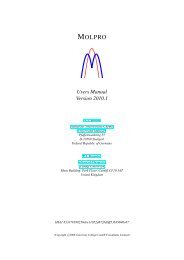Carbon−Carbon Coupling Reactions Catalyzed by Heterogeneous ...
Carbon−Carbon Coupling Reactions Catalyzed by Heterogeneous ...
Carbon−Carbon Coupling Reactions Catalyzed by Heterogeneous ...
You also want an ePaper? Increase the reach of your titles
YUMPU automatically turns print PDFs into web optimized ePapers that Google loves.
<strong>Heterogeneous</strong> Pd <strong>Catalyzed</strong> C−C <strong>Coupling</strong> <strong>Reactions</strong> Chemical Reviews, 2007, Vol. 107, No. 1 167<br />
allyl acetates. Unlike in a genuine Heck reaction where<br />
hydride is eliminated after the oxidative addition, acetate<br />
serves as leaving group in this case (Table 80). 270 Substrates<br />
bearing electron-donating groups required longer reaction<br />
times (entry 5). However, substrates with strongly electronwithdrawing<br />
substituents led to rapid isomerization of the<br />
alkenes to the thermodynamically more stable styryl system<br />
(entries 6 and 8). Both chloro and bromo substituents (entries<br />
2 and 3) were tolerated under the reaction conditions. 270<br />
Table 80. Heck-Type <strong>Coupling</strong> of Allyl Acetate with Various<br />
Aryl Iodides<br />
a Isolated yields. b 5% Pd/C was used; 18% of internal olefin was<br />
observed.<br />
A possible mechanism (Scheme 59) for this reaction<br />
involves initial oxidative addition to Pd(0) followed <strong>by</strong><br />
carbopalladation of the olefin. Subsequent �-acetoxy elimination<br />
gives the final allyl product. Reduction of the resulting<br />
Pd(II) to Pd(0) is most likely achieved <strong>by</strong> coordination of<br />
an amine base followed <strong>by</strong> �-hydride transfer and reductive<br />
elimination of hydrogen iodide.<br />
9. Pd on Solid Support in Tandem <strong>Reactions</strong><br />
Solid-supported Pd-catalyzed coupling reactions <strong>by</strong> C-Cbond<br />
formation, such as Sonogashira or Heck reaction, can<br />
Scheme 59. Proposed Mechanism for the Heck-Type<br />
<strong>Coupling</strong><br />
be followed <strong>by</strong> further addition reactions. In this way,<br />
heterocycles can be formed under cyclization.<br />
9.1. Sonogashira <strong>Coupling</strong> in Tandem <strong>Reactions</strong><br />
When o-aminoaryl iodides are submitted to Sonogashira<br />
reactions, intramolecular addition of the amino group to the<br />
C-C triple bond can lead to the formation of indoles. As<br />
one possibility, Pd/C-CuI could be used as catalyst (Scheme<br />
60). 271 The intermediate compound 225 resulting from the<br />
Sonogashira C-C coupling reaction between 2-iodoaniline<br />
and phenylacetylene was never observed in these experiments.<br />
This indicates that the heteroannulation is rapid under<br />
the reaction conditions.<br />
Scheme 60. Pd/C-<strong>Catalyzed</strong> Synthesis of 2-Phenylindole a<br />
a Reaction conditions: 5 mmol of 2-iodoaniline, 5 mmol of phenylacetylene,<br />
15 mmol of Et3N, 1 mol % Pd/C, 1 mol % CuI, 15 mL of DMF/H2O<br />
(1:1), 120 °C,6h.<br />
Pal and co-workers reported a general one-pot synthesis<br />
of 2-alkyl/aryl-substituted indoles 228 via Pd/C-mediated<br />
coupling/5-endo-dig cyclization of terminal alkynes with<br />
o-iodo-N-mesylanilines 227 in water. 272 The reaction was<br />
carried out using PPh3 and CuI as cocatalyst and 2-aminoethanol<br />
as a base (3 equiv). The reaction appeared to tolerate<br />
a variety of functional groups present in the alkynes and did<br />
not require the use of any organic cosolvent (Table 81).<br />
A greater variety of N-substituents at the 2-iodoanilines<br />
was possible when Pd-NaY was used as catalyst (Table<br />
82). 273 Cu catalysis was not necessary. It was found that the<br />
product formation largely depended on the solvent, base, and<br />
reaction temperature. The recycled catalyst showed good<br />
reusability in this heteroannulation reaction.<br />
[Pd(NH3)4] 2+ /(NH4)Y as catalysts allowed implementation<br />
of the synthesis of 2-phenylindole starting from o-iodoaniline<br />
and phenylacetylene under Cu-free conditions in 72% yield<br />
(Table 83). 191 Similarly, microporous [Pd(NH3)4] 2+ /NaY or<br />
mesoporous [Pd]/SBA-15 silica could be used for the<br />
syntheses of a series of 2-substituted indoles. 29<br />
When o-iodophenols were submitted to Sonogashira<br />
coupling with alkynes the subsequent intramolecular cyclization<br />
led to benzo[b]furans. Because of its relevance to<br />
natural products and to pharmacy many 2-substituted benzo-<br />
[b]furan derivatives were prepared in this way during the<br />
last years using a homogeneous palladium catalyst and<br />
copper iodide as cocatalyst under mild conditions. 274-277 As<br />
a heterogeneous alternative, Pd/C was applied in the presence












![Hetero [6+3] Cycloaddition of Fulvenes with N-Alkylidene Glycine ...](https://img.yumpu.com/35423358/1/190x245/hetero-6-3-cycloaddition-of-fulvenes-with-n-alkylidene-glycine-.jpg?quality=85)




